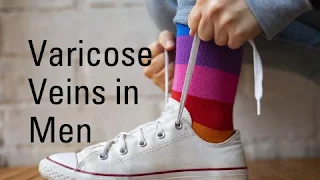Varicose veins are often thought to be a condition that primarily affects women, but did you know that men are also prone to developing varicose veins? While the condition is more common in women, men can suffer from varicose veins too, with a significant number of cases reported each year. In this article, we'll explore the causes, symptoms, risk factors, and treatment options for varicose veins in men, shedding light on this often-overlooked issue.
What Are Varicose Veins?
Varicose veins are swollen, twisted veins that are visible just beneath the skin's surface. They occur when the valves within veins weaken, allowing blood to pool and veins to enlarge. While varicose veins are most commonly seen in the legs and feet, they can also develop in other parts of the body.
How Do Varicose Veins Affect Men?
While varicose veins are often considered a cosmetic issue, they can cause discomfort and lead to more serious health problems if left untreated. In men, varicose veins can lead to symptoms such as:
- Pain and Swelling: Men with varicose veins may experience pain, heaviness, and swelling in the affected area.
- Itching or Burning: Varicose veins can cause itching or a burning sensation in the legs.
- Visible Veins: The twisted veins become visible and can appear dark blue or purple, which can be bothersome.
- Skin Changes: In more severe cases, varicose veins can lead to skin discoloration, ulcers, or bleeding.
Causes and Risk Factors for Varicose Veins in Men
Just like women, men can develop varicose veins due to a variety of factors. Here are the most common causes and risk factors:
- Aging: As men age, the valves in their veins weaken, making it easier for blood to pool and causing varicose veins to develop.
- Genetics: Family history plays a significant role in determining whether someone will develop varicose veins. If your father or grandfather had them, you may be more likely to develop varicose veins yourself.
- Occupation: Jobs that involve standing for long periods, such as construction or retail work, increase the risk of varicose veins in men.
- Obesity: Being overweight or obese puts extra pressure on your veins, increasing the likelihood of varicose veins developing.
- Lack of Physical Activity: Leading a sedentary lifestyle can contribute to poor circulation and increase the risk of developing varicose veins.
Treatment Options for Varicose Veins in Men
If you're experiencing symptoms of varicose veins, there are several treatment options available. The right treatment will depend on the severity of your condition, symptoms, and overall health. Here are some of the most common treatment options:
1. Lifestyle Changes
Making simple lifestyle changes can help prevent varicose veins from getting worse. These include:
- Regular exercise to improve circulation
- Maintaining a healthy weight to reduce pressure on the veins
- Avoiding standing or sitting for long periods of time
- Wearing compression stockings to reduce swelling and discomfort
2. Sclerotherapy
Sclerotherapy involves injecting a solution into the affected veins, causing them to collapse and fade from view. This is a popular treatment for smaller varicose veins and spider veins.
3. Laser Treatment
Laser therapy is a non-invasive procedure that uses concentrated light to treat varicose veins. This method is ideal for smaller veins and offers quick recovery times with minimal discomfort.
4. Endovenous Laser Therapy (EVLT)
For larger veins, Endovenous Laser Therapy (EVLT) uses laser energy to close the vein from the inside. It is a minimally invasive procedure with a shorter recovery time than traditional surgery.
5. Vein Stripping Surgery
In more severe cases, surgery may be required to remove the damaged veins. This procedure, known as vein stripping, involves making small incisions to remove the affected veins. It is typically reserved for larger veins that don’t respond to other treatments.
When Should You See a Doctor?
If you are experiencing symptoms of varicose veins, it's important to see a healthcare professional. Early treatment can help prevent the condition from worsening and reduce the risk of complications. Seek medical attention if you notice:
- Severe pain or swelling in your legs
- Bleeding from a varicose vein
- Skin ulcers or discoloration around the veins
- Persistent discomfort or heaviness in the legs
Conclusion
Varicose veins in men are a common issue that can cause discomfort and impact quality of life. While they are often thought of as a women’s health concern, men are just as susceptible to developing varicose veins. If you're experiencing symptoms, there are various treatment options available to help manage the condition. From lifestyle changes to minimally invasive treatments, early intervention can provide relief and improve your leg health. Always consult with a healthcare professional to determine the best course of action for your specific case.

